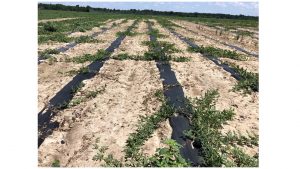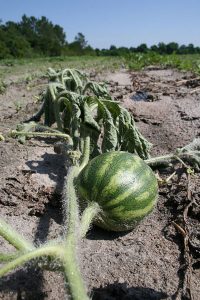
By Clint Thompson
Watermelon growers can protect their investment against fusarium wilt disease before they transplant, according to Bhabesh Dutta, University of Georgia (UGA) Cooperative Extension vegetable plant pathologist at the UGA Tifton campus.
CHECK FOR SYMPTOMS
Dutta emphasizes that it’s important for growers to check their seedlings before planting for any type of wilting symptoms associated with fusarium wilt.
“If the seedlings display wilting symptoms before planting, please disregard those seedlings,” Dutta said. “This will help growers not to introduce further inoculum in the field.”
Fusarium wilt symptoms can appear at any growth stage. If they appear at the seedling stage, the plants will not even make it to vines. Plants infected with the fusarium wilt pathogen will eventually die if the infection is severe. The plant can produce fruit if the infection is weak, but when it begins using the energy necessary to produce fruit, the plant will likely decline and slowly die.

Watermelon plants can become infected in multiple ways. The pathogen can produce spores that survive in the soil, be seedborne and be introduced to fields where watermelons have never been grown.
TIMING IS CRITICAL
Watermelon growers can also protect their crop by applying fungicides,
specifically Proline, right after transplanting, Dutta said.
“If you can apply this fungicide early enough right after transplanting, then it will provide some efficacy. If you miss that window of opportunity, then it will put your crop at risk to fusarium infection,” Dutta warns.
Transplanting dates are also a key factor to consider. Dutta noted that research has shown that the most severe symptoms occur when soil temperatures are cooler compared to warmer temperatures. Growers who put plants in the ground during mid-March are more at risk for fusarium wilt compared to those who plant in late March or early April. Dutta admits this may not be practical for some farmers who aim to harvest their crop right before July 4, when market prices are at their highest.
However, this approach of delayed planting combined with effective fungicide is still under investigation. Hopefully a management package can be extended to watermelon growers soon, Dutta added.
He encourages growers to further monitor their plants later in the season to see if wilt shows up in the field. If symptoms appear, farmers need to work with their county agents and specialists to devise appropriate management strategies.
Get more information here about fusarium wilt disease.









